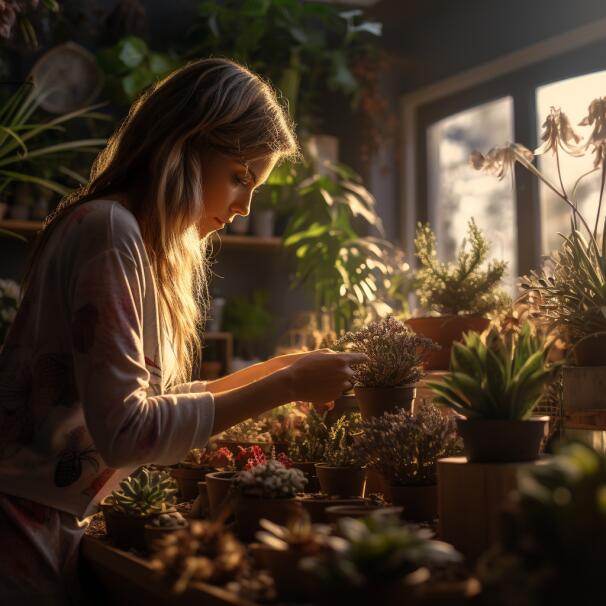
Table of contents
• Introduction
• Choosing the Right Plants
• Watering Your Plants
• Providing Adequate Lighting
• Fertilizing Your Plants
• Pest Control
• Repotting Your Plants
• Conclusion
Introduction
Welcome to our comprehensive guide on properly caring for your plants. As plant enthusiasts, we believe that taking care of your green friends is not only rewarding, but also crucial for their health and survival. Proper plant care ensures that your plants thrive, and as a result, create a beautiful space within your home. In this blog, we explore the importance of proper plant care and the many benefits of having plants in your home. Let's dive in!
Choosing the Right Plants
Choosing the right plants requires a bit of research and consideration. Before purchasing, make sure to research the type of plant, its care needs, and whether it's suitable for your home environment. Consideration of environmental factors such as the amount of light your home receives, the humidity, and temperature plays a significant role in ensuring your plant thrives. Don't just pick a pretty plant without considering whether it's the right fit for your home. Remember, not all plants are created equal.
Watering Your Plants
Well, congratulations, you have successfully gone through the first hurdle of choosing the right plant! Now comes the crucial part, watering them. Plants are like humans - they need just the right amount of water to survive. Over-watering or under-watering can lead to disastrous results. You don't want to be responsible for your plant's untimely death, do you?
So, what do you do? Firstly, stick to the age-old technique of poking your finger into the soil to determine if it's dry or moist. This technique never gets old. Secondly, different plants have different watering needs. Consider the type of plant you have and its natural habitat - whether it's a desert or a tropical climate. Research the watering frequency for your specific plant and stick to it.
Well, if you still can't get the hang of it, there's always the option of getting a self-watering pot. It saves you the trouble of figuring out when to water your plant. Smart, isn't it?
Providing Adequate Lighting
Providing Adequate Lighting: Positioning your plants in the right spot is crucial for their growth and wellbeing. Some plants require direct sunlight while others thrive in indirect light. Make sure to research the lighting needs of each plant before purchasing.
Plants that do not receive enough light may become leggy and weak, while those that get too much light may suffer from sunburn. Aim to position your plants in areas that receive the appropriate amount of light for their specific needs.
If your plant is not getting enough light, you can consider using artificial lighting to supplement natural light. On the other hand, if your plant is getting too much light, you may need to move it to a shadier spot or provide some shade.
Remember, each plant is unique and may require different lighting conditions. Keep an eye on your plants and adjust their positioning accordingly. Your plant babies will thank you for providing them with the optimal lighting conditions for their growth and development!
Fertilizing Your Plants
When it comes to fertilizing your plants, timing is crucial. Generally, it's a good idea to fertilize during the growing season, which is usually spring and summer for most plants. However, it's important to research the specific needs of your plants, as some may require year-round fertilization.
When it comes to selecting a fertilizer, there are many options available, such as organic and synthetic fertilizers. Organic options like compost and manure are great for enriching soil, while synthetic options provide a specific balance of nutrients. It's important to read the label and choose a fertilizer that is well-suited for your plant's needs.
As for how much fertilizer to use, it's important to follow the instructions provided on the label. Over-fertilizing can actually harm your plants, so be sure to measure carefully. In general, a little bit goes a long way. With proper timing and the right balance of nutrients, your plants will thrive.
Pest Control
Pests can be a nightmare for plant owners. Identification of the problem is the first step towards pest control. Look for signs like tiny holes in leaves, webs in the corners, or even insects visible on the leaves. Natural pest control methods include spraying neem oil or soap water, placing coffee grounds around the plants, or introducing ladybugs to the garden. Remember to keep a check on your plants as a stitch in time saves nine.
Repotting Your Plants
The time has come to give your plant a new home, but when should you repot? Here's a tip: if you see roots growing through the drainage holes or the soil is drying out quickly, it's time to repot. Be sure to choose the right soil for your plant's needs - a cactus blend for succulents and a moisture control mix for ferns. Don't forget the proper technique - gently remove the plant from the old pot, loosen the roots, and place it in the new pot with fresh soil. Happy planting in your plant's new home!
Conclusion
Proper plant care is crucial for their health and your wellbeing. A thriving garden not only brings joy but also a sense of accomplishment. So, put on your gardening gloves and show some love to your green friends.

